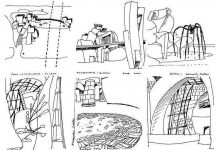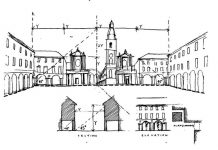Without humans settling down more or less permanently at specific locations, the erection of large and complex edifices would have been an unimaginable feat; the toil required would probably have been pointless, if people would not occupy them for many years and had to abandon them before their completion. Moreover, without permanent settlement in situ and involved with construction only occasionally, it is doubtful whether people would accomplish even that. Nomads never built pyramids, stadiums, skyscrapers, or theaters. Nomads have no need for architects—for better or for worse.
Nothing, therefore, contributed to the development of architecture in the long run more than the invention of agriculture, a technological achievement that radically changed the fate of the human species. The cultivation of land is an investment that yields returns after several months of hard work. Moreover, because plants have roots and cannot travel, people become attached to their land along with their crops. It is estimated that modern hunter-gatherer societies spend about three to four hours daily to secure their food supplies and a total of five to six hours daily on all tasks required to sustain their living standards. They are constantly on the move following their food sources. Unable or unwilling to store more than a minimal food surplus lest they compromise their mobility, they make do with little material wealth, but, unlike the overwhelming majority of modern people, they gain considerable spare time. Admittedly, nowadays these societies are using technologies and knowledge developed by farmer societies they usually associate with. Still, the required amount of work to meet their needs in the past, before people learned how to cultivate land, must not have been all that different, at least while there was no overpopulation and climatic conditions were favorable.
Agriculture was most probably invented independently in at least five or six separate regions worldwide, when local human populations had risen to such levels that naturally renewable food sources were no longer sufficient. Thus, they were forced to find other ways to increase food production. Possibly after other survival strategies—such as increased mobility or decreased population density—proved ineffective, or were unattainable or not employed for reasons we are not aware of, they opted for a radical innovation. Evidence suggests that for the first time, about 11,000 years ago, in the region known as the Fertile Crescent (an area extending from modern Israel to north Syria and from southeast Turkey to modern Iraq), humans discovered that they could grow plants bearing edible fruit. Almost simultane-ously, people (initially more often in mountainous terrains) started breeding goats for meat and much later for milk and skin; and used dogs—an animal species that had just emerged—for herding as well as for hunting.
Slowly but steadily, the cultivation of land expanded into increasingly remote areas exercising its dramatic charm to the greater part of the planet. Up to that point, people used to live in small groups (called clans) of usually twenty to fifty individuals based on kinship. These clans formed part of bands and tribes and moved from one place to another, securing their food supply, which was not difficult while the land was thinly populated. They were able, however, to settle down permanently in areas rich in sources of food, water, and abundant in raw materials.
While not imposing permanent settlement, the invention of agriculture (a “delayed return” activity) strengthened the tendencies for it—some groups probably still moved to nearby areas once a productive crop cycle was completed. Settled communities tended to be quite populous. Complex power balances were formed, which seem to have allowed for or directly led to the establishment of some kind of social stratification. By 5000 BCE in arguably one of the most developed areas of the world, the southeast part of the Fertile Crescent in modern Iraq—an area known by its Greek name, Mesopotamia, the land between rivers Tigris and Euphrates—the need to organize production, irrigate farming land, and transport its fruit became more pressing. It was now possible to accumulate surplus. The possibility to control and manage this surplus as a defense mechanism against poor harvests ensued; writing, which was invented much later, around 3000 BCE, arguably the most important tool in spreading the benefits of civilization, was perhaps born out of the need for systematic record keeping. The need for specialized labor began to multiply. Tasks were probably no longer differentiated by gender alone, as seems to have been the case in much less complex societies, in which—based on modern ethnographic data—all men and all women had the knowledge and skills to perform most required actions for their own and their families’ subsistence. Specialization increased productivity, but also intensified interdependencies.
Humans now lived in large permanent settlements (cities) with rules on cohabitation, which everyone accepted or was subjected to. The allocation of different roles in these complex societies allowed differentiation in power, authority, and prestige between its members and systematically undermined the relatively egalitarian relations inherited from the past. Administration was handled in an increasingly less collective way; elite classes were formed. The inhabitants of cities—more likely craftsmen, merchants, and administrators than farmers—acquired considerably more privileges than the inhabitants of rural areas had.
Cults, developed in response to metaphysical questions, were codified into religions—though these may have originated in the more distant past, before the advent of agriculture. Priesthoods increasingly monopolized intermediation between the divine and mankind. Mechanisms were put into place and arguments were devised to organize societies more efficiently and strictly. Having developed a rather holistic worldview, the Sumerians—the most advanced people of the region—seem to have believed that people are complex entities. Gilgamesh, the hero of the first known epic, was two-thirds god and one-third human 1; and ordinary people had in some sense a part common to all members of their family: this part was often identified with the family god who guarded and guided them. Everybody was thus embedded in a stable and eternal world order and his/her office and his/her position and function within the society defined for a large part his/her identity; even the gods were deified functions rather than individuals, as the ancient Greek deities were later meant to be.
By the early fourth millennium BCE, some of the cities had developed imperialistic aspirations. Powerful men secured leading positions in their communities. These men gradually usurped leadership and, in-dispensable as they were in protecting their city in times of need or peril, they expanded their authority at the expense of others. Hereditary trans-fer of social status and the privileges that came with it became general practice. Administration became more authoritarian and used force—on which it acquired more or less a monopoly—at an unprecedented scale. The states were born.
The new leaders were not the only beneficiaries; an entire cast serving the institutions legitimizing authority saw their privileges augment. Of those institutions, the most important was religion. As it transpired in the following millennia, one of its most effective tools was architecture.
Groups tend to claim rights over the land that provides them with the means for their subsistence—albeit through hard work—initially without physical means. They develop beliefs and myths associated with it; soon, though, they also resort to matter. The first states that were established thousands of years ago had to devise means to denote that they had appropriated swaths of land; and to denote that they were structured in a way that enabled them to protect their perceived rights under firm leaderships. Tangible symbols have probably had a crucial role in signifying, as well as in maintaining those two basic pillars of the new order: the territory of the state and its hierarchical structure. Monumental architecture has played a major role in this enterprise. The immobility of materials weighing thousands of tons, from which edifices representing authority were made, was alone a blatant statement of a bond to the territory as strong as the bond between farmers and their land. Immobility in space, however, also denoted immobility in time; as such, it sanctioned the status quo—a status quo favorable to the leader and the ruling class.
In modern southern Turkey, in Göbekli Tepe, a building complex was recently unearthed, which (if it is correctly dated) seemingly refutes our conviction that highly sophisticated edifices are the brainchild of the aforementioned era. It is an 11,000-year-old sanctuary, consisting of several megalithic structures, geometrical in shape and with a quite composite ground plan—comparable to Stonehenge, which is 6,000 years younger. The people who built it, or some of them at least, were probably permanently settled in the area and subsisted on hunting and foraging. In any case, they had given up one of those traits of nomadism: the lack of any artifact that could not be packed and carried with them as they migrated from one place to another, or one that could be constructed easily at their next temporary settlement. We do not yet know the degree to which their society was stratified. What is difficult for one to imagine is that the construction of the complex was not assigned to some members of the community who were relieved from the burden of performing all necessary tasks to sustain their families and themselves. It may well have been the need to feed those working in its construction, or the worshippers who gathered there, that encouraged the transition from food gathering to agriculture; the latter could ensure sufficient food supply at a point of time known beforehand.
It seems that the sanctuary—the largest of its kind in the whole re-gion and unique in many aspects—became the pivotal point of an extended area practically as well as symbolically, by being a place where people from local communities gathered, and by responding to their metaphysical concerns. In this context, one should note that Vittorio Gregotti’s claim that the origins of architecture lie not in the primitive hut but in placing a stone on the ground to recognize a place in the midst of an uncharted territory and an unknown universe, acquires a tangible foundation.
The apparent discontinuation of comparable building activity, however, may suggest that such an endeavor could have added an unbearable burden to the community, and that the investment in effort and time needed to accomplish such a feat was not sustainable. In other words, it was not worthwhile, and that’s why it was not repeated. The function of architecture to visualize in monumental terms the practical as well as the symbolical center of community life seems to have faded and sunk into oblivion for millennia, only to reemerge in Mesopotamia and independently in various other regions around the globe from 4000 BCE on. Thus, monumental architecture was “reinvented” in order to serve first and foremost the further strengthening of social cohesion, which was gradually under way, albeit at the cost of equality and justice.
It is in Eridu, a city founded around 5400 BCE, where we can clearly trace architecture’s steady steps toward monumentality. The temple of Enki, built before 5000 BCE, was initially just a small room made of mud bricks, measuring approximately three by three meters. A few years later, this early building gave way to a newer one, of similar dimensions, but with a niche on the wall opposite the entrance where the statue of the god was placed. Although not spectacular, the differences between the two temples were significant: the ground plan of the new temple had become more complex in order to emphasize the importance of the god. On the remains of that temple, a larger and more complex one was built, and on its ruins a still larger one. Enki’s temple has seventeen discernible phases spanning 2,000 years, developing unambiguously in one direction. It became increasingly detached from the ground and the access to it became increasingly difficult.
There is probably no more eloquent example of this new role—or was it the very birth?—of architecture in Mesopotamia than the so-called Oval Temple. Built around 2700 BCE in the city of Tutub (modern Khafajah in Iraq), this building complex expanded over a surface of nearly 8,000 square meters; large temples were not rare at that time and they coexisted alongside the dozens or hundreds domestic sanctuaries and small neighborhood temples that dotted the cities.
The Oval Temple, enclosed by two rather irregular oval-shaped outer walls, looked like a fortress. Its distinctive shape may have been intended to mark the temple proper as the most significant element of the enclosure without having to situate it at its geometric center. The oval shape allowed a longitudinal axis pass through successive gateways and courtyards; at its end the main temple was built on an elevated platform. Grain was accumulated in storerooms around the central, ceremonial courtyard to be rationed by the priesthood. They performed a very important service redistributing the surplus and managing crises, which only heightened their already strong authority; by that time temples were power centers competing with palaces and large estates for control over important resources.
The temple was located at the eastern end of the city, near one of the gates of the outer wall. That area had been inhabited for centuries, and at the time was densely populated and had narrow streets. To build the temple, dwellings were demolished and graves were removed. The entire surface was dug to a depth of eight meters to the water level. Small bones and twigs, old building materials and food waste were removed. The pit was then filled with pure, sifted sand. The symbolism was clear: the site designated for the temple was purged of all things human, perishable—of all things reminding people that time goes by, and that things change.
The temple was supposed to secure human contact with the heavens and the gods, and also the underworld and the deities who lived there. Its erection illustrates the view of Martin Heidegger, the controversial twentieth-century German philosopher, who argued that building creates a place; buildings do not occupy already existing places.3 A place, argued Heidegger, becomes what it is by the very construction of the edifice, by the nurture and care in its construction and by the bonding generated between human beings and earth through the labor of building.
As years went by, ziggurats, those geometrically shaped, tiered stacks of brick, rose in the plains throughout Mesopotamia, presumably based on the shape of mountains. Rain was born on the mountains giving life to land and humans. Ziggurats are the places where gods would descend to meet humans or, to be more precise, to meet their emissaries—high-ranking priests.
The main temples, the shrines, were rather small edifices at the top of the ziggurats. Unlike Christian churches, mosques, or synagogues, they were not intended for admitting the congregation of the faithful. From there, the priesthood observed the stars in order to prepare detailed tables useful for making calendars and predicting the future; astrology was highly developed in that part of the world. This imbued ziggurats with immense moral authority. Their prominence within cities remained unchallenged for centuries. However, circumstances changed and thus 2,000 years later, ziggurats were reduced to mere appendices of palaces of extremely powerful kings, who monopolized power in the cities and states they ruled.
In the Oval Temple, people nominated one of their artifacts as an indispensable intermediary between them and their deities. This artifact was placed in a specific location and cleansed of all traces of previous activities. The relationship between people and their gods no longer took place solely in the realm of the imaginary, in their minds and souls. With buildings like the Oval Temple, this relationship acquired a visible form. Thus, it was meant to become more credible and univocal, as well as thoroughly controlled in dogmatic terms and, as such, a force unifying the community. In the clearer terms, it had been established that the gods were not directly accessible to everyone. Contact with them required rituals that only a select few had been initiated into (the priesthood), and was only possible in certain circumstances (at the top of a huge building); it was a contact possible only in conditions of spatial and temporal stability. Architecture helped to consolidate the respective (religious in our case) “rule” and the given social order. Inextricably bound to the place, its product—the sacred edifice—expressed and helped perpetuate authority.
No building would be what it is, had it not been erected where it is. No place would be what it is, had an edifice not been built there. In Jerusalem, the Dome of the Rock stands on a hill where, as Muslims believe, Muhammad set his ladder to ascend to the heavens. It is the hill where Jews believe—probably for good reason—the second Temple of Solomon once stood, and where they kept their most revered heirlooms. The Romans demolished this temple and built a temple dedicated to one of their gods, driving the Jewish people into exile two thousand years ago. It is a hill for which blood and tears have been shed for millennia; a hill for which world peace and stability are in peril still to this day; a hill more important than any other nearby.
Historically, architecture has assisted societies and communities in building identities intertwined with certain locations. This contribution has two sides. On the one hand, it offers a sense of belonging. On the other hand, it gives people the certainty that the place where they are settled belongs to them forever. For this reason, they have the right to exclude others that might also have a claim on it. Normally, this does not contribute to building peaceful, open, and tolerant societies with an eye toward the future, but societies chained voluntarily to conflicts of the past.
Could it be that architecture is condemned to bind people to the land where they happen to be at a specific moment? Or is there an architecture conceivable detached from place? In the first decades of the twenty-first century, anything we still build renews the fundamental question raised by the construction of the Oval Temple of Khafajah 5,000 years ago and the answer that it received with the excavation of its foundations …



















